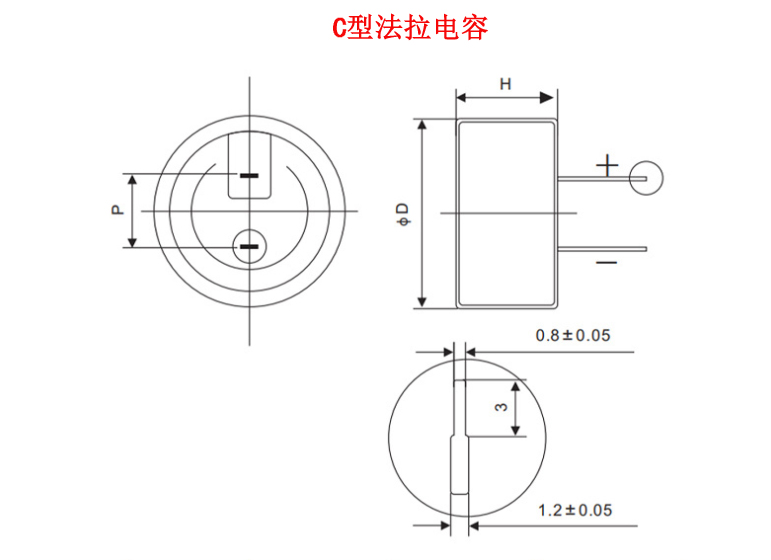Consulting phone:
135-3037-2041
(Mr.Wang)
Product introduction:
Farad lithium capacitor, also known as double-layer capacitor, Farad capacitor, gold capacitor and supercapacitor, is a chemical element developed from the 1970s and 1980s. Supercapacitors store energy through polarized electrolytes without chemical reaction, and the process of energy storage is reversible, which is precisely because this supercapacitor can repeatedly charge and discharge hundreds of thousands of times.
Product Specifications:
model | Rated voltage V | Capacity F | Internal resistance Ω1KHz | 24h leakage current uA | Product Size | ||
Diameter D±0.5 (mm) | Length H±0.5 (mm) | Pitch ±0.5 (mm) | |||||
YKY5R5C104 | 5.5 | 0.1 | 50 | 5 | 13.5 | 6.5 | 5 |
YKY5R5C224 | 5.5 | 0.22 | 40 | 5 | 13.5 | 6.5 | 5 |
YKY5R5C334 | 5.5 | 0.33 | 40 | 8 | 13.5 | 6.5 | 5 |
YKY5R5C474 | 5.5 | 0.47 | 20 | 8 | 13.5 | 6.5 | 5 |
YKY5R5C105 | 5.5 | 1.0 | 15 | 10 | 21 | 7.5 | 5 |
YKY5R5C155 | 5.5 | 1.5 | 10 | 10 | 21 | 7.5 | 5 |
Product size:

Product display:


Product use:

Product packaging:

Product application scope:
The pulse power performance, long service life and reliable operation in extreme temperature environment of supercapacitors are fully suitable for those applications requiring repetitive electric energy pulses in a fraction of a second to a few minutes, making them energy storage and power transmission solutions for transportation, renewable energy, industrial and consumer electronics and other applications, such as electric vehicles (EV/HEV), military Light rail, aviation, electric bicycles, backup power supply, power generation (wind power generation, solar power generation), communication, consumer and entertainment electronics, signal monitoring RAM, detonators, automobile recorders, intelligent instruments, vacuum switches, digital cameras, motor drives, intelligent three meters, UPS, security equipment, communication equipment, flashlights, water meters, gas meters, taillights, small household appliances and other fields have broad market prospects.
![1669255349608834.jpg 9KNWP1HKPP)MWOMO9}A%K]U.jpg](http://en.szsyky.cn/data/upload/202211/1669255349608834.jpg)
Test method:
1. Electrostatic capacity test method:
(1) Test principle
The electrostatic capacity of supercapacitor is measured by the method of constant current discharge of the capacitor and calculated according to the formula. C=It (U1-U2), where: C - electrostatic capacity, F; I - Constant discharge current, A; U1, U2 - voltage, V; Discharge time required from t-U1 to U2, S
(2) Test procedure
Charge the capacitor with a current of 100A until the capacitor is charged to the working voltage and the voltage is constant for 10 seconds. Then discharge the capacitor with a current of 100A, taking U1 as 1.2VU2 as 1.0V. Record the discharge time within the voltage range, the total circulating electrostatic capacity, and take the average value.
2. Stored energy test
(1) Test principle:
The energy test of super capacitor is carried out by discharging the capacitor to 1/2 of the working voltage at constant power within the voltage range given by the capacitor. The output energy W of capacitor is obtained from the relationship between constant discharge power P and discharge time T, that is, W=P. T
(2) Test procedure
Charge the capacitor to the working voltage with a constant current of 100A, and then keep it constant until the charging current drops to the specified current (traction type 10A, starting type 1A). After 5 seconds of standstill, discharge the capacitor to 1/2 of the working voltage with a constant power, record the discharge time and calculate the value. Cycle the measurement for 3 times and take the average value.
3. Equivalent series resistance test (DC)
(1) Test principle
The internal resistance of the capacitor is measured according to the sudden change of voltage within 10ms after the capacitor disconnects the constant current charging circuit. In the formula: R-internal resistance of capacitor; U0 - Voltage before capacitor cut-off charging; Ui - Voltage within 10 ms after switching off charging; I - Cut off the current before charging.
(2) Measuring process
Charge the capacitor with a constant current of 100A, disconnect the charging circuit when 80% of the charging working voltage is reached, use a sampling machine to record the voltage change within 10 ms after the capacitor is powered off, calculate the internal resistance, repeat for 3 times, and take the average value.
4. Leakage current test
After the capacitor is charged to the rated voltage with a constant current of 100A, the capacitor is charged at this voltage for 30min at a constant voltage, and then it is left open for 72h. In the first three hours, record the voltage value every minute, and in the remaining time, record the voltage value every ten minutes.
Calculate the self discharge energy loss, SDLF=1 - (V/VW) 2, and the calculation time points are respectively 0.5,1,8,24,36,72h
Note: The voltage tester must have high input impedance to minimize the sound of the film.